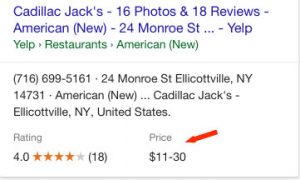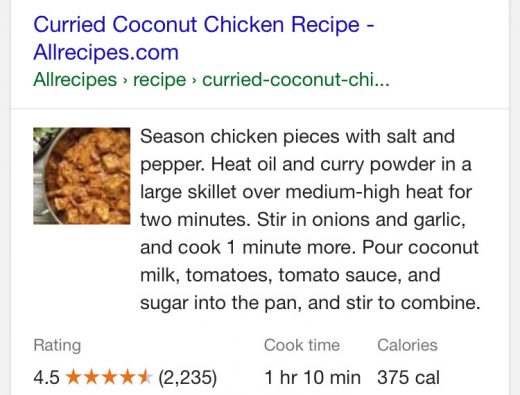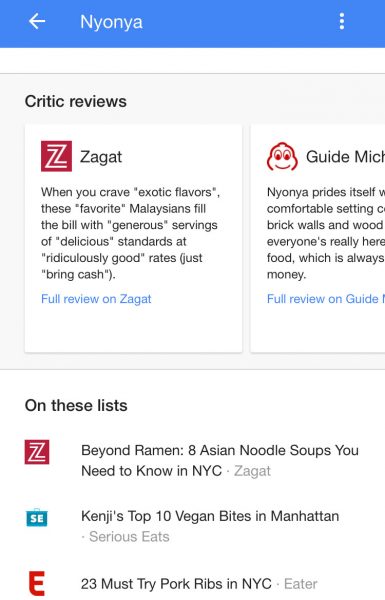Understanding Google My Business & Local Search
Thoughts on the Recent Rollout of Aggregate Reviews, Snippets & Critic Reviews in Google SERPS
Since early August with the roll out of Critic Reviews and Top 10 Lists and with the recent rollout of Reviews from the web and a significant review snippet display upgrade, Google has been on a rich snippet tear. Here are some my thoughts, big and small, about these changes.
Do you see these changes as anti-competitive? Do you see them as helping your business? I would love to hear from you.
 Rich Snippets and Aggregate Review Counts are significantly more prominent in the search results with upgrades to both the Knowledge Panel and the review snippet display.
Rich Snippets and Aggregate Review Counts are significantly more prominent in the search results with upgrades to both the Knowledge Panel and the review snippet display.
Not only has Google increased review rich snippet prominence in the mobile display but has also included pricing information.
 This new review snippet display has been changed for other entities as well. You can see in this Recipe snippet that the third column was also used to include even more information. It is interesting to speculate how that might be used for Local. (H/T to Aaron Weiche.)
This new review snippet display has been changed for other entities as well. You can see in this Recipe snippet that the third column was also used to include even more information. It is interesting to speculate how that might be used for Local. (H/T to Aaron Weiche.)
 Google has looked far and wide for additional review content and has included a lot of content from sites Zomato and FourSquare as well as others providing site reviews.
Google has looked far and wide for additional review content and has included a lot of content from sites Zomato and FourSquare as well as others providing site reviews.
It would appear that sites like FourSquare and Zomato became more visible in brand searches as well.
 As noted by Joy Hawkins having your own review system like GetFiveStars seems to offer SERP display benefits particularly for multi location businesses. (I am a principal in GetFiveStars.)
As noted by Joy Hawkins having your own review system like GetFiveStars seems to offer SERP display benefits particularly for multi location businesses. (I am a principal in GetFiveStars.)
 There is, as always, a ranking element in the order that the aggregate data shows in the Knowledge Panel. This, at first glance, seems to mirror the organic order of the review sites with snippets on the brand search. There also seems to be a correlation with total review count. Which also correlates somewhat to organic positioning… ooh my head is spinning.
There is, as always, a ranking element in the order that the aggregate data shows in the Knowledge Panel. This, at first glance, seems to mirror the organic order of the review sites with snippets on the brand search. There also seems to be a correlation with total review count. Which also correlates somewhat to organic positioning… ooh my head is spinning.
 This upgrade, following closely on the heels of the prominent Critic Review display, was accompanied by another new update to the Guidelines for critic reviews and review snippets.
This upgrade, following closely on the heels of the prominent Critic Review display, was accompanied by another new update to the Guidelines for critic reviews and review snippets.
These guidelines make it totally obvious that critic reviews must be human curated. While no mention was made whether Top 10 lists also need to be so curated one assumes that might be the case. (Although this is not at all clear.)
With the rollout of Critic review displays, it is likely that these sorts of reviews have taken on a more important ranking impact than UGC reviews. Google in articulating the newest guidelines seems to be encouraging the development of this sort of content for businesses other than restaurants.
Yelp has come and gone from the KP display of aggregate reviews while TripAdvisor has not been seen even though both rank highly and frequently on brand searches. Yelp, for those of you new to Local, has had a long standing and contentious relationship vis a vis Google’s use of their review content that precedes their anti-trust testimony.
 Google has searched far and wide for review content to include in this upgrade. I would speculate that Yelp and TripAdvisor apparently chose not to participate in the Knowledge Panel display. I would posit that Google, not having as much ability to display these two leader’s aggregate review content, perhaps chose to dilute Yelp’s and TA’s impact by prominently showing all of the other review content around the internet?
Google has searched far and wide for review content to include in this upgrade. I would speculate that Yelp and TripAdvisor apparently chose not to participate in the Knowledge Panel display. I would posit that Google, not having as much ability to display these two leader’s aggregate review content, perhaps chose to dilute Yelp’s and TA’s impact by prominently showing all of the other review content around the internet?
Interesting question that we can only speculate about. I am sure that we will more on the topic from Yelp and Google.
Your thoughts?
© Copyright 2025 - MIKE BLUMENTHAL, ALL RIGHT RESERVED.

Comments
7 Comments
Hey Mike,
This is an info-packed post. Can I ask for some clarification regarding the guidelines and services like GetFiveStars, please? From the guidelines:
“Sites must collect ratings information directly from users and not from other sites.”
So, with a service like GetFiveStars and a client like Barbara Oliver, your product is drawing reviews DIRECTLY from customers, and is not publishing those reviews elsewhere than on Barbara’s website (http://barbaraoliverandco.com/reviews-testimonials/). Is that correct, and would those be the 2 guidelines any review-gathering service would need to meet to be guideline-compliant?
I’m starting to see people ask if ‘X’ service operates within or outside of the revised Google guidelines, and want to be sure I get what the criteria is. I’ve read the guidelines, but would love your expert opinion, too. Thanks!
@Miriam
I would agree with your assessment. Those two rules seem to be the ones to be concerned with at the moment to be compliant with Google’s new guidelines.
Although it t isn’t required at this time I would go one step further with GetFiveStars’ clients (and anyone with a similar product) and recommend that they future proof themselves by:
-showing all feedback, good and bad.
– including a link to a feedback TOS that indicates when they might be forced to remove a review (i.e. Client used profanity, promoted a competitor or wasn’t a customer)
The world will move in this direction in the next six months and they should start moving there now.
Interestingly we only see a half point drop on average when businesses go this route.
Currently a company’s own website can appear in the “Reviews from the web” section of the Knowledge Panel even if they don’t have a review system in place. I have noticed examples of this for websites that have simply added aggregate review markup based on a seemingly fabricated rating and review count. This type of manipulation has been utilized by some for a long time to produce glowing rich snippet results. I’m assuming this tactic will cease to work at some point but I’m not holding my breath.
I can only second Tom. I too have seen KP and organic results featuring third-party reviews that are marked-up with aggregrate-rating on the embedding website.
Hope this will have an end soon.
Very helpful, Mike. I appreciate your smart pointers
Is there a way to disallow Google from adding the ‘Reviews from the Web’ to your local cards? For some big brand, multi-location retail businesses, this is a useless feature! Reviews mean very little for retail chains, whose primary customers don’t care what your Foursquare or even Google review rating is. They just want toilet paper. They just want beer. They just need toothpaste. Et cetera.
I like this addition for more service-based businesses, but I don’t see this adding much value to the search experience for large retail chains. What do you think?
@Kyle
There is no way that I can think of that would disallow these reviews from around the web… all businesses service, Mom & PoP bricks and mortar and chains are subject to the reality of reviews. And Google has decided that more is better.
The best that a business can do is to do some reputation development of their own and work to make sure that the ones that do show are favorable… for even if its just toilet paper, someone might go down the street if the other guy is easier, better..
Comments for this post are closed.